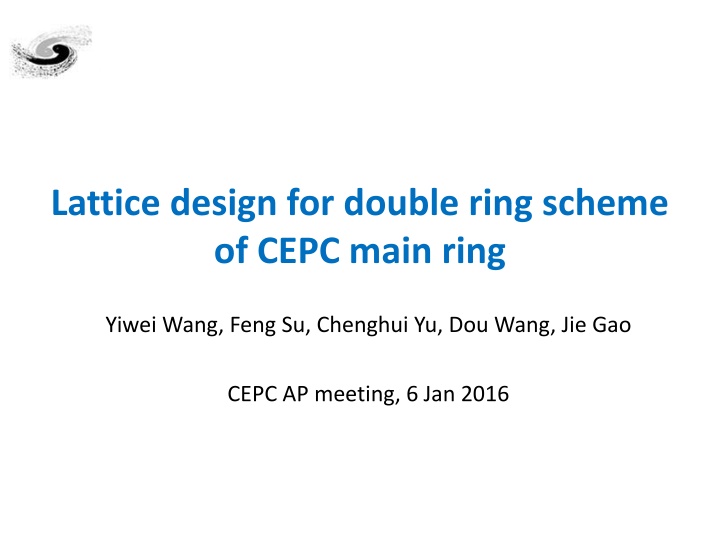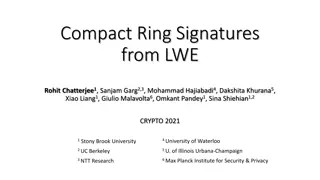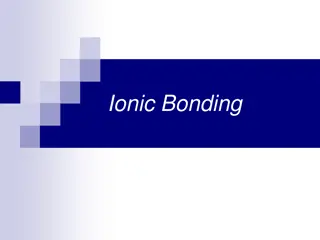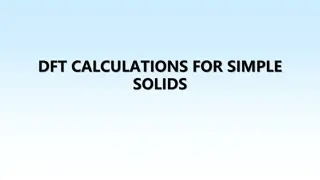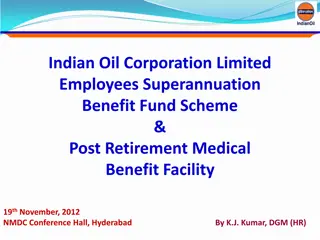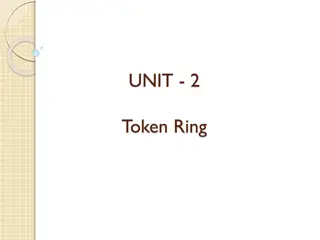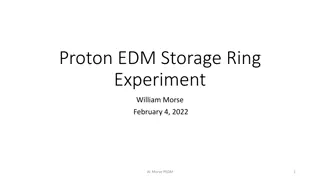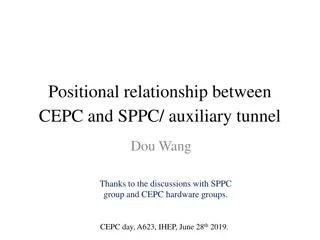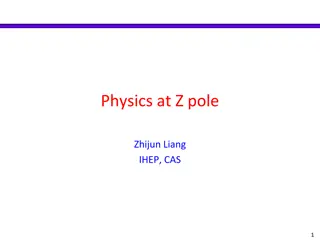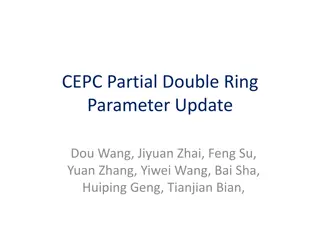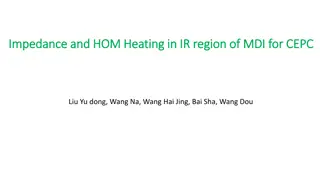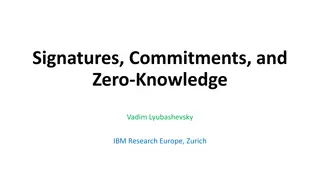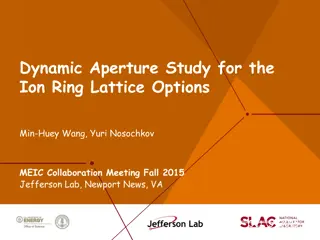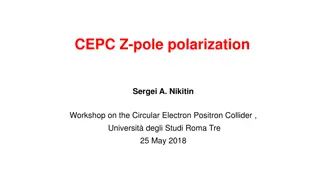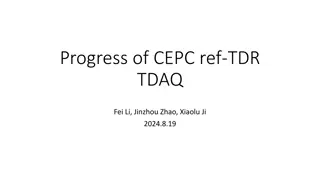CEPC Main Ring Double Ring Scheme Lattice Design
Lattice design and parameters for the double ring scheme of the Circular Electron Positron Collider (CEPC) main ring discussed at the CEPC AP meeting in January 2016. The outline covers the CEPC parameters for C=100km, including the lattice design and geometry for different regions. Details on energy, circumference, beam characteristics, RF parameters, and more are provided. Additionally, specific information on the Arc region, FODO cell, and RF region designs is outlined, showcasing innovative strategies to optimize beam performance and minimize losses.
Download Presentation

Please find below an Image/Link to download the presentation.
The content on the website is provided AS IS for your information and personal use only. It may not be sold, licensed, or shared on other websites without obtaining consent from the author.If you encounter any issues during the download, it is possible that the publisher has removed the file from their server.
You are allowed to download the files provided on this website for personal or commercial use, subject to the condition that they are used lawfully. All files are the property of their respective owners.
The content on the website is provided AS IS for your information and personal use only. It may not be sold, licensed, or shared on other websites without obtaining consent from the author.
E N D
Presentation Transcript
Lattice design for double ring scheme of CEPC main ring Yiwei Wang, Feng Su, Chenghui Yu, Dou Wang, Jie Gao CEPC AP meeting, 6 Jan 2016
Outline CEPC parameters for C=100km Lattice design and geometry for the Arc region Lattice design and geometry for the RF region Lattice design and geometry for the IR region
CEPC parameters for C=100km wangdou20161202-100km Pre-CDR H-high lumi. H-low power W Z Number of IPs Energy (GeV) Circumference (km) SR loss/turn (GeV) Half crossing angle (mrad) Piwinski angle Ne/bunch (1011) Bunch number Beam current (mA) SR power /beam (MW) Bending radius (km) Momentum compaction (10-5) IPx/y (m) Emittance x/y (nm) Transverse IP(um) x/ y/IP RF Phase (degree) VRF(GV) fRF(MHz) (harmonic) Nature z(mm) Total z(mm) HOM power/cavity (kw) Energy spread (%) Energy acceptance (%) Energy acceptance by RF (%) n Life time due to beamstrahlung_cal (minute) F (hour glass) Lmax/IP (1034cm-2s-1) 2 2 2 2 2 2 120 54 3.1 0 0 3.79 50 16.6 51.7 6.1 3.4 120 100 1.67 15 2.9 0.97 644 29.97 50 11 1.3 120 100 1.67 15 2.9 0.97 425 19.8 33 11 1.3 80 100 0.33 15 3.57 1.05 1000 50.6 16.7 11 3.1 45.5 100 0.034 15 5.69 0.46 10520 232.1 8.0 11 3.3 0.12/0.001 0.93/0.0049 10.5/0.07 0.0075/0.054 160.8 0.11 45.5 100 0.034 15 5.69 0.46 65716 1449.7 50 11 3.3 0.12/0.001 0.93/0.0049 10.5/0.07 0.0075/0.054 160.8 0.11 0.8/0.0012 6.12/0.018 69.97/0.15 0.118/0.083 153.0 6.87 650 2.14 2.65 3.6 (5cell) 0.13 2 6 0.23 47 0.144 /0.002 1.56/0.0047 15/0.097 0.0126/0.083 131.2 2.22 650 (217800) 2.72 2.9 0.64 (2cell) 0.098 1.5 2.2 0.26 52 0.144 /0.002 1.56/0.0047 15/0.097 0.0126/0.083 131.2 2.22 650 (217800) 2.72 2.9 0.42 (2cell) 0.098 1.5 2.2 0.26 52 0.1 /0.001 2.68/0.008 16.4/0.09 0.0082/0.055 149 0.63 650 (217800) 3.8 3.9 1.0 (2cell) 0.065 650 (217800) 3.93 4.0 3.93 4.0 1.0 (1cell) 0.037 6.25(1cell) 0.037 1.5 0.26 1.1 0.18 1.1 0.18 0.68 2.04 0.95 3.1 0.95 2.05 0.84 4.08 0.91 11.36 0.91 70.97
Lattice design and geometry for the Arc region FODO cell Dispersion Suppressor ex=1.53e-09 m*rad, rhoB_i=12576 m, rhoB_o=12576.6 m LB_i=37.41351251093299, LB_o=37.4152975067589
Lattice design and geometry for the RF region An electrostatic separator, combined with a dipole magnet to avoid bending of incoming beam (ref: Oide, ICHEP16) x=0.6 m, =0, Dx=0, Dx =0
L*= 1.5m x*= 0.144mm y*= 2mm GQD0= -200T/m GQF1= 200T/m LQD0=1.69m LQF1=0.90m FFSR Lattice design Ec < 100 keV within 280m Phx~0.25+2.5 Phy~0.25+2.5+0.125 to keep ARC sextupoles and FD on phases
L*= 1.5m x*= 0.144mm y*= 2mm GQD0= -200T/m GQF1= 200T/m LQD0=1.69m LQF1=0.90m FFSL Lattice design Ec < 300 keV within 160m Ec < 600 keV within 160m Phx~0.25+2.5 Phy~0.25+2.5+0.125 to keep ARC sextupoles and FD on phases
Geometry matching Initial idea is to match the geometry with only dipoles in one direction. This section should also has the function of horizontal chromaticity correction. Many ways were tried but all failed because the initial deviation is larger than 0.6m. We have to use inverse direction dipole to bend the orbit back. A longer matching section will be also necessary.
Emittance and synchrotron radiation first two bends in FFSL
Dynamic Aperture Qx /Qy =0, 2 families in ARC Qx/Qy=.54/.61 for half ring Synchrotron motion included 100 turns
Summary Lattice designs for the Arc/RF/IR region prepared The geometry of the double ring need to be carefully matched.
